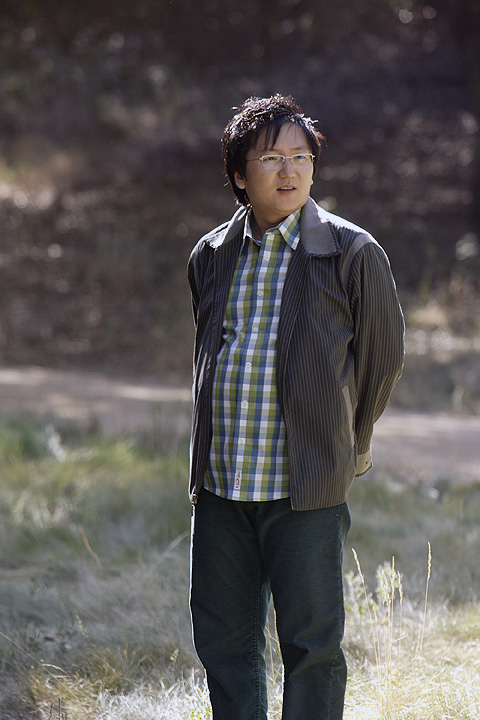I have to admit I haven’t spent every second this week watching pilots. I took a little time out for Heroes. Here are a few little things I noticed:
The first commercial break didn’t come until 22 minutes in. Wasn’t that great? You’d really settled into the story by then. I love long long openings.
The episode followed about twelve characters. Claire and her dad, Alejandro and Maya (the new brother-sister team), Molly and Matt, Suresh, Hiro, Hiro’s dad, Nathan Petrelli and his mother. Of the main players, we were only missing Niki and her family and Isaac.
In many cases, the characters were paired up and there was a little storyline for the pair and separate stories for each character in the pair. We had a little story arc on Claire and her dad: him giving her advice on fitting into their new life, some scenes of them with their family and Claire not coping with the new family order. We also had a Claire storyline about the new school and possible new love interest for her and another little thread about dad and his new job.
In every act, we got a nice long hit of each of the stories. It felt very meaty.
Heroes episodes don’t have stories that arc out to an ending and give you that satisfying feeling of completed story. Instead they suck you in with a series of cliff hangers. Not only are there cliffhangers at the end of every act and every episode, there are cliff hangers at the end of almost every sequence. You’re on the edge of your seat waiting for the next installment of each storyline. It’s a very soapy form, which I love.
Back to pilots…


VeryReadablebill
Yeah, call it “soapy” but another name might be strong narrative impuse. It’s the technique that keeps a reader reading as well as a viewer viewing.
The other thing that enhanced those sequence payoffs was the music. Whoever is doing it really understands the value and contribution music makes to a show.
admin
I’m adding “strong narrative impulse” to my vocabulary since “soapy” is such a low rent name for a technique that so effectively drives the viewer forward.
BenS.
I haven’t watched the Heroes second season opener yet, but I don’t like the term “strong narrative impulse” for the mini-cliffhanger technique at the end of every section. The term seems too general. I’m going to call it the cliffhanger-to-cliffhanger technique for now, or “c2c” for short.
And I DO love the c2c technique. I’m more interested in prose writing than screen writing*, but I’ve noticed that in books that I feel are particularly strong the chapters do the same thing. In books that I think are extremely strong I’ve noticed what I think is an improvement upon the simple c2c technique. I’ll call it “threaded cliffhanger to cliffhanger” or “tc2c” for short.
I’ll describe tc2c and then provide an example of it in action. I haven’t talked about this a lot, so I hope it’s not confusing.
Now, as I understand it, simple c2c does two things structurally.
1) Resolves the prior scene’s cliffhanger.
2) Creates a new cliffhanger for the next scene.
In tc2c a scene, pretty much in order, does four things structurally.
1) Resolves the prior scenes cliffhanger.
2) Raises a question/problem to catch the reader’s/viewer’s attention.
3) Solves the question/problem raised in #2.
4) Creates a new cliffhanger for the next chapter.
Here’s an example from a book I love where practically every chapter is an example of the tc2c technique.**
At end the last scene a protagonist, a carpenter (if I remember correctly) got a piece of secret government information from a contact, the very possession of which could mean death and the secret police are after it. He lives in a near police state, so danger is everywhere. The question/cliffhanger is, of course, what can he do with the info? Ignore it? Burn it? Turn it over to the police?
At the beginning of the next scene the character is disguised as a woman and on a train.
This resolves the cliffhanger. Now we know the character is making a run with the info someplace.
Also, a new question is raised, where is he taking the info? Why is he disguised?
The meat of the chapter/scene resolves this question. He”™s been using this disguise for years to cover his visits to a butcher shop that provides the cover for an underground, illegal, newspaper. The carpenter has been the newspaper”™s editor for years. This resolves the question of while he”™s disguised, where he”™s going, and why he”™s going there.
Of course, the scene ends with another cliffhanger. Everyone at the newspaper”™s secret hideout has been killed or captured, the secret police knew about it all along. Now the protagonist is back on the run.
I think the tc2c technique improves upon the c2c because there”™s a complete narrative arc is every scene so the viewer is left satisfied that they learned something (about the character or world) with what they saw, while also giving them a hook to drag them into the next scene with.
*And yet I’m reading this blog, cause I think storytelling is storytelling.
**Perdido Street Station.
admin
Wow, Ben. What an amazing analysis. Maybe I’ll track the next episode of Heroes and see whether it fits the c2c model or the tc2c model.
In some ways, the tc2c model is like those shows that are combine an episodic plot with an arcing plot to deliver both story satisfaction and cliffhanging anticipation. Only taken to the micro level within the show.
It gives viewers/readers the best of both worlds: a feeling of completion and a desire for more.